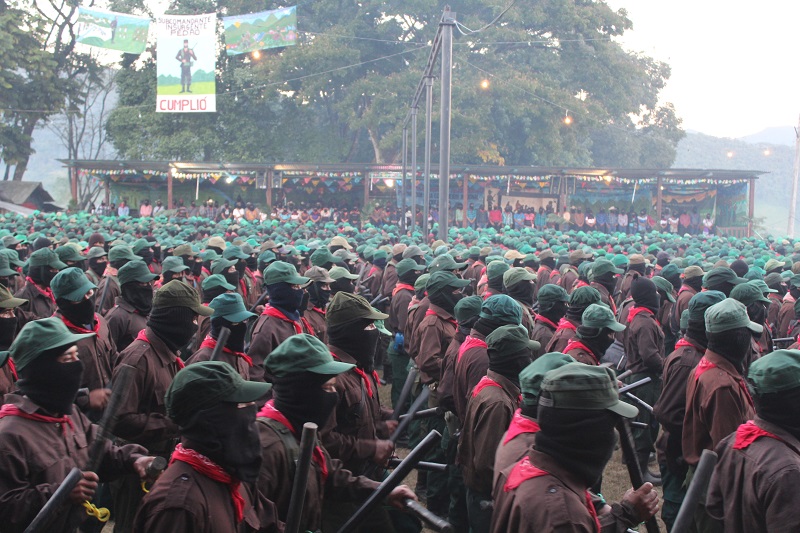
Convocation to the Events: “Zapata Lives, Samir Lives, The Struggle Continues” on the 100th Anniversary of the Assassination of General Emiliano Zapata Salazar
Convocation to the Events:
“Zapata Lives, Samir Lives, The Struggle Continues”
on the 100thAnniversary of the Assassination of General Emiliano Zapata Salazar
Given that:
Our brother Samir Flores Soberanes was murdered by the neoliberal regime—we don’t know if it was the government, big business, their criminal cartels, or all three together.
The so-called “Fourth Transformation” began with Miguel de la Madrid Hurtado, was intensified by Carlos Salinas de Gortari, continued as a war of conquest by Ernesto Zedillo Ponce de León, Vicente Fox Quezada, Felipe Calderón Hinojosa, and Enrique Peña Nieto; and is now extended through the long-term project of Andrés Manuel López Obrador and the Party of National Regeneration [MORENA]. For the originary peoples, the only “real change” will be an increase in lies, tricks, persecution, threats, imprisonment, displacement, murder, mockery and disrespect, human exploitation and natural destruction—in sum, the annihilation of the collective life that we are.
The current neoliberal government headed by Andrés Manuel López Obrador has its sights set on our peoples and territories. Using its “National Institute for Indigenous Peoples”, it has put into place a web of cooptation and disorganization that clears the way for a war whose principal front will be industrialization. This war will be implemented via infrastructure projects and violence and backed by the armed forces and the soon-to-be National Guard, casting a dark shadow of death and destruction over the originary peoples of our country.
We restate our firm opposition to the neoliberal policies of old and new governments; to the referendums or whatever they choose to call them whose only purpose is our displacement from and dispossession of our territories; to mining, to the damming of our rivers, to highway construction and the acceleration of real estate speculation throughout our lands, to the construction of neoliberal megaprojects of death like the Integral Project for Morelos, the Trans-isthmus Corridor, and the Mayan Train.
We have not forgotten that the struggle led by General Emiliano Zapata Salazar and the Liberation Army of the South and Center represented and continues to represent the interests and aspirations of our peoples and of millions of the exploited in Mexico and the world. This upcoming April 10 is the 100thanniversary of the cowardly murder of General Emiliano Zapata Salazar by the political regime that, despite its “transformations”, continues to govern today.
Given this, we convoke a National Assembly of the indigenous peoples of the National Indigenous Congress/ Indigenous Governing Council, adherents to the Sixth Declaration of the Lacandón Jungle, the Support Networks for the Indigenous Governing Council, and collectives and organizations organized in struggle against capitalism, to take place on April 9 of this year in the indigenous community of Amilcingo, municipality of Temoac, Morelos, from 10:00am-6:00pm.
We also convoke a national and international mobilization to mark the 100th anniversary of the murder of General Emiliano Zapata Salazar. The mobilization’s epicenter will be Chinameca, Morelos, on April 10, 2019, beginning at 9:00am.
The schedule of activities will be published shortly.
(Continuar leyendo…)
SAMIR LIVES! THE STRUGGLE CONTINUES! Declaration from the Third National Assembly of the National Indigenous Congress, the Indigenous Governing Council, and the EZLN
SAMIR LIVES! THE STRUGGLE CONTINUES!
Declaration from the Third National Assembly of the National Indigenous Congress, the Indigenous Governing Council, and the EZLN
To the peoples of the world:
To those organizations and collectives acting in resistance and rebellion:
To the national and international Sixth:
To the media:
As Ayuuk, Binizza, Chinanteco, Chol, Chontal, Guarijío, Maya, Mayo, Mazahua, Mazateco, Mixteco, Nahua, Nayeri, Otomí, Popoluca, Purépecha, Raramuri, Tepehuano, Tlapaneco, Tojolabal, Totonaco, Tzeltal, Tsotsil, Wixárika, Yaqui, Zoque, and Quichua (Ecuador) peoples, we have come together for the Third National Assembly of the National Indigenous Congress and the Indigenous Governing Council. Today, almost 100 years after the assassination of General Emiliano Zapata, we now face the pain and rage brought by the war waged against our peoples and the murder of our compañero Samir, killed for defending the land and his people. As a national assembly, we send our embrace of solidarity and struggle to his family and the community of Amilcingo, Morelos. As the CNI-CIG and the EZLN, for whom compañero Samir will always be a glimmer of light, we send our solidarity and collective embrace.
Samir was killed by the neoliberal regime—we don’t know if it was the government, the business class, their criminal cartels, or all three together. The path was laid for this cowardly murder by the new federal executive, Andrés Manuel López Obrador [AMLO], through his offers of support not to those below, but rather to the owners of money and power, while making veiled threats against those of us who defend and fight for life. AMLO has promised to hand over to big business and the military elite what neoliberal capitalism and all of its various bad governments never could: our land. His administration’s new Agrarian Development Law aims to dismantle collective organization and collective property forms, deeming as “development” what is actually shameless theft and destruction. This is accompanied by military threats to our peoples via his “National Guard” in what amounts to the total reconfiguration of our country.
What above they call “transformation” has always mean the same thing for our peoples: we give our lives so that powerful and oligarchic interests, fewer and fewer but bigger and bigger, can live off of oppression, exploitation, and destruction. The so-called “Fourth Transformation”[i] follows the same path as the previous three, although more brutally and cynically, if such a thing is possible.


